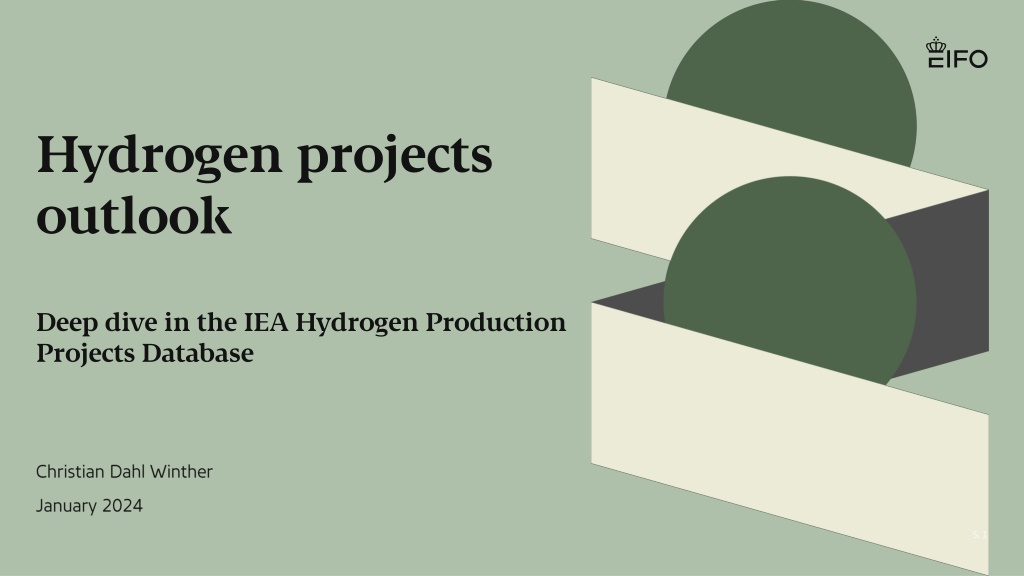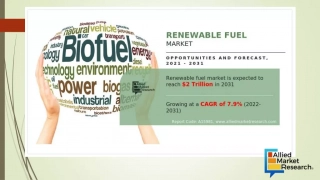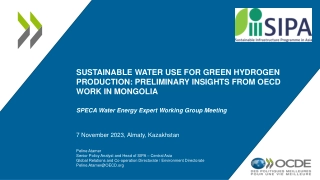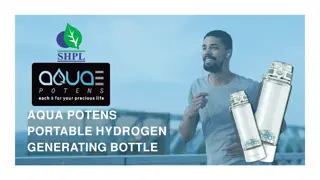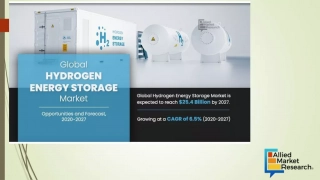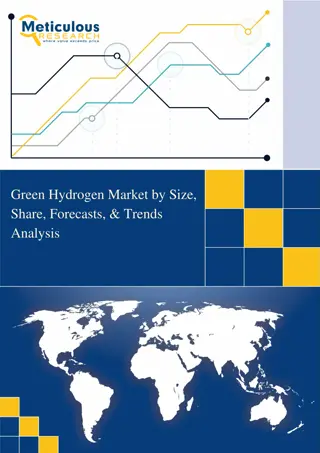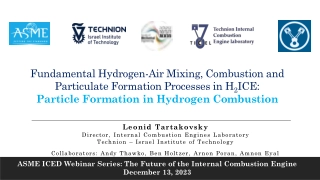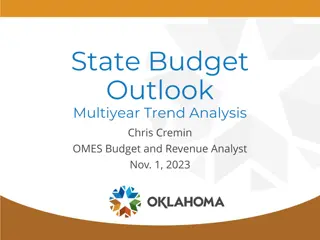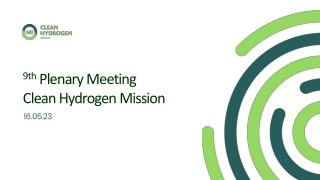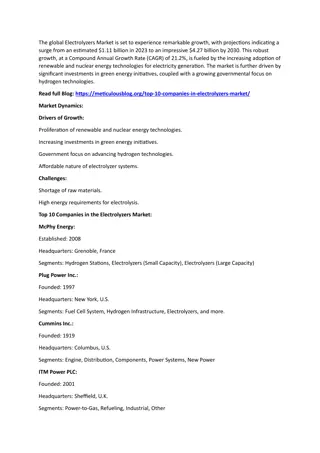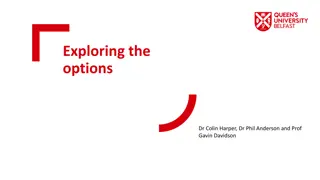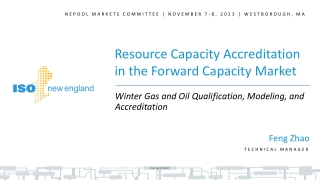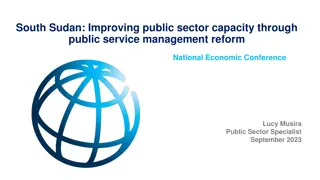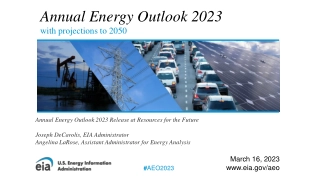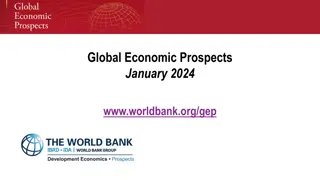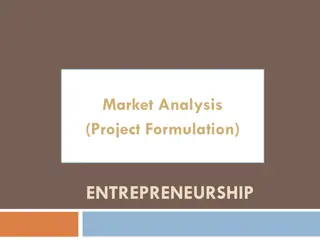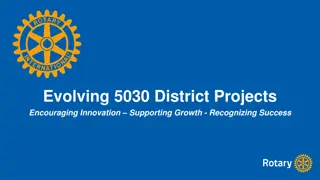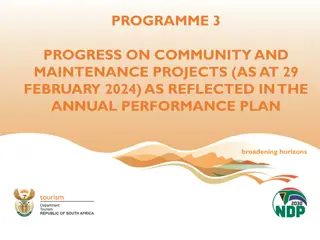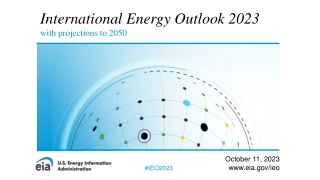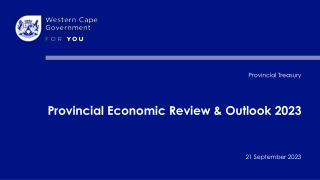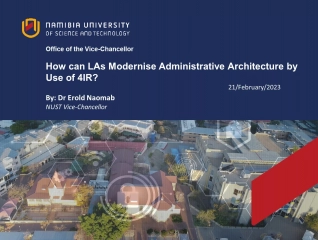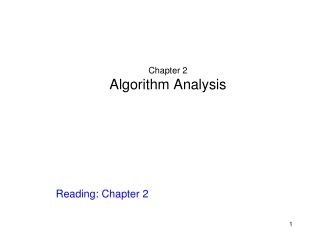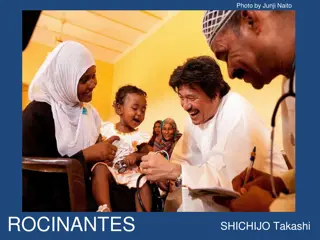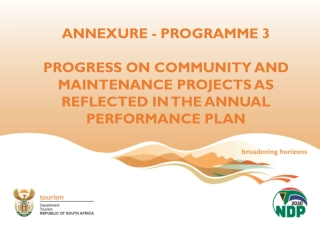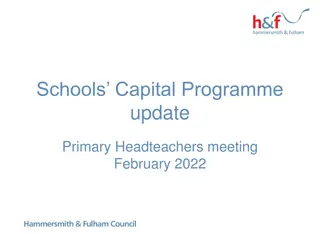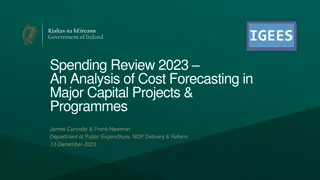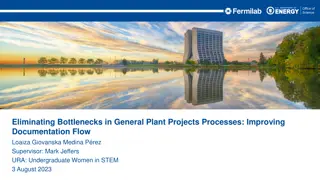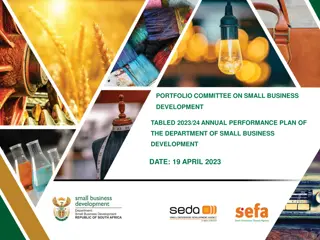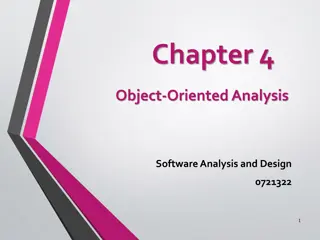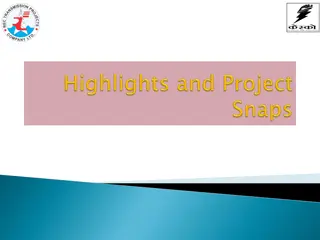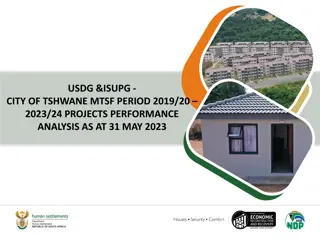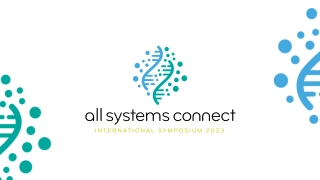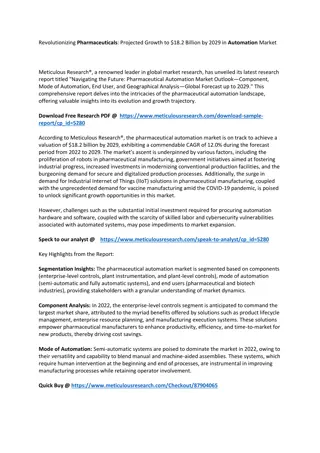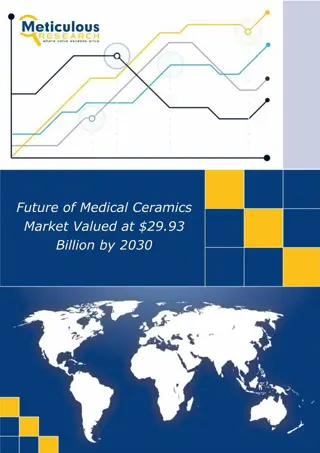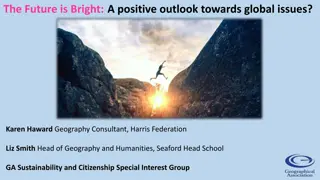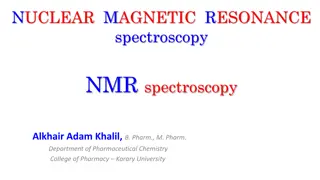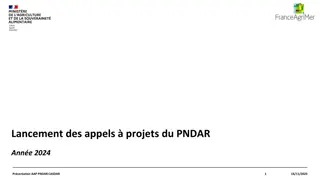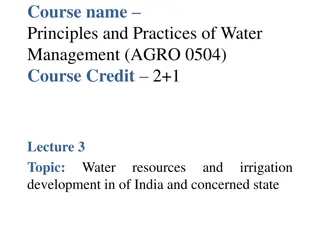Global Hydrogen Projects Outlook and Electrolyzer Capacity Analysis
This outlook delves into the IEA Hydrogen Production Projects Database to provide an update on the status of global hydrogen projects. It covers the timing and capacity of new electrolyzer installations, projecting significant growth in electrolyzer capacity by 2030 to meet Net Zero Emissions Scenarios. The analysis shows the increasing trend in project size and the expected distribution of new electrolyzer capacity over the coming years. With a focus on green hydrogen production through electrolysis, it highlights the need for substantial investment and development in the low-carbon hydrogen industry.
Global Hydrogen Projects Outlook and Electrolyzer Capacity Analysis
PowerPoint presentation about 'Global Hydrogen Projects Outlook and Electrolyzer Capacity Analysis'. This presentation describes the topic on This outlook delves into the IEA Hydrogen Production Projects Database to provide an update on the status of global hydrogen projects. It covers the timing and capacity of new electrolyzer installations, projecting significant growth in electrolyzer capacity by 2030 to meet Net Zero Emissions Scenarios. The analysis shows the increasing trend in project size and the expected distribution of new electrolyzer capacity over the coming years. With a focus on green hydrogen production through electrolysis, it highlights the need for substantial investment and development in the low-carbon hydrogen industry.. Download this presentation absolutely free.
Presentation Transcript
Hydrogen projects outlook Deep dive in the IEA Hydrogen Production Projects Database
About the Hydrogen Projects Outlook This outlook provides a status update on the global pipeline of hydrogen projects. The information is extracted from the IEA s 'Hydrogen Production Projects Database' and presented in a series of illustrative graphs. We believe that the IEA maintains the most comprehensive overview of the global project pipeline. It is updated once a year (the latest version was released in November 2023), so the data is recent at the time of writing. The database contains almost 2000 different hydrogen projects and features various characteristics about each project, including geography, maturity, the (expected) year of first production, size, source of input, type of output, and electrolyzer technology. Our primary focus is on projects that use electrolysis to produce green hydrogen, but we will also provide a few data points for the entire low-carbon hydrogen industry. The calculations in this outlook are based on projects in the database that have achieved a certain degree of maturity in their development, understood as projects in the 'Feasibility study,' 'FID/Construction,' or 'Operational' stages. Projects in the Concept phase' are excluded from the analysis, as they are considered more uncertain. IEA s Hydrogen Production Projects Database is available through this link: IEA Hydrogen Production Projects Database
Timing of new electrolyzer capacity (accumulated) Timing of new electrolyzer capacity To date, globally, less than 2 GW of electrolyzer capacity has been installed. By 2024, this figure is expected to increase to 13 GW, further rising to 54 GW in 2025. GW (accumulated) 200 180 For comparison, current installed power generation capacity globally is close to 10.000 GW. 160 140 According to the IEA, by 2030, approximately 180 GW of electrolyzer capacity is expected to be operational. An additional 60 GW of capacity may be added to this total, as these projects have advanced past the concept phase, but there is no indication of their first operational year. 120 100 80 60 To achieve the IEA s Net Zero Emissions Scenarios, an estimated 590 GW of electrolyzer capacity is needed by 2030 (Hydrogen Analysis - IEA). The current pipeline of more mature projects covers only 30-40% of this requirement. 40 20 0 2020 2021 2022 2023 2024 2025 2026 2027 2028 2029 2030 GW announced Note: The database contains projects of around 60 GW which are indicated as having matured past the concept phase into the feasibility study phase, but without any indication of first operational year. These project are not included in the figure. Source: IEA Hydrogen Production Projects Database, 2023.
Timing of new electrolyzer capacity Timing of new electrolyzer capacity 2024 is set to become a big year. More than 10 GW expected online including major projects in Australia, Canada and Argentina. GW Number of Projects 50 200 From 2025, the annual inflow of new electrolyzer capacity is expected in the range of 20-40 GW, although there seems to be a tendency towards less new capacity announced for years immediately before and after 2030. 45 180 40 160 35 140 The pipeline of new projects after 2030 is somewhat thinner, which is naturally since this is further into the future. Many of these projects are naturally also at more of a concept phase . 30 120 25 100 20 80 In terms of average project size, there is a tendency for later projects to be bigger than earlier projects. The average project size during the period 2025-2027 is around 250 MW increasing to 650 MW during the period 2028-30. 15 60 10 40 5 20 0 0 2023 2024 2025 2026 2027 2028 2029 2030 2031 2032 GW Number of Projects (right axis) Source: IEA Hydrogen Production Projects Database, 2023.
Deep dive: Timing of new electrolyzer capacity in Denmark (accumulated) Timing of new electrolyzer capacity in Denmark The figure illustrates the accumulated electrolyzer capacity in Denmark. It indicates that 2025 is expected to be a year of significant inflow of new capacity, reaching approximately 2 GW. GW (accumulated) 20 18 For comparison, total Danish wind- and solar capacity currently stands at around 15 GW. 16 14 Considering the historical speed of deployment, this projection seems somewhat optimistic, even with the IEA s database being updated as recently as October 2023. 12 10 Top 5 gigawatt-sized projects in Denmark 8 Project name Status Year Capacity (GW) 6 H2 Energy Europe Esbjerg green hydrogen Feasibility study 2025 1 4 H st - Esbjerg green ammonia plant Construction 2026 1 2 Hydrogen Island Concept 2030 10,5 GreenGo Tarm plant Concept 2030 2 - 2020 2021 2022 2023 2024 2025 2026 2027 2028 2029 2030 rsted - Skovgaard Energy project in western Denmark Concept N/A 2,9 Mature projects Including concept Note: We report the IEA s database as is, without making any changes to the data based on our knowledge of specific projects. For example, CIP currently expects H st to reach FID in 2025 and commence operations in 2028/29. Source: IEA Hydrogen Production Projects Database, 2023.
Project maturity At present, 23% of projects are operational, yet these projects only constitute 0,5% of all announced capacity (1 GW). More than half of the operational capacity is situated in China. 59% of projects are currently in the Feasibility study phase. Projects in the Feasibility study phase account for 93% of all announced capacity (209 GW). 18% of projects have progressed into the FID/construction phase. Those projects account for 7% of all announced capacity (15 GW). Electrolyzer capacity (MW) Number of projects 1,110 (0%) 15,149 (7%) 284 (23%) Feasibility study Feasibility study FID/Construction FID/Construction Operational Operational 740 (59%) 227 (18%) 208,664 (93%) Note: Figures exclude projects in the concept phase and where project maturity status is unknown. Source: IEA Hydrogen Production Projects Database, 2023.
Geographical distribution of electrolysis project pipeline New electrolyzer capacity by country The graph illustrates the geographical distribution of the top 10 countries in terms of hydrogen electrolysis production capacity, with the inclusion of Sweden, France, and Denmark for reference. MW Number of Projects 60,000 140 120 50,000 Australia, Mauritania, and Chile emerge as the top three countries in terms of electrolyzer capacity. 100 The production capacities are categorized based on their final products. Notably, projects in countries aiming for large-scale exports focus on easily transportable chemicals, such as ammonia. This includes Australia, Mauritania, Chile, Kazakhstan, and Oman. 40,000 80 30,000 60 20,000 In contrast, projects in Europe predominantly target hydrogen, emphasizing its transportability through a regional pipeline system. It's worth noting that the pipelines for Mauritania and Kazakhstan consist of just three and one project, respectively, introducing a degree of uncertainty. 40 10,000 20 0 0 All projects depicted in the figure have progressed beyond the 'concept phase . AUS MRT CHL KAZ OMN ESP USA CHN NLD DEU SWE FRA DNK Hydrogen Ammonia Methanol Other Number of Projects (right axis) Source: IEA Hydrogen Production Projects Database, 2023.
Geographical distribution of electrolysis project pipeline including concept phase New electrolyzer capacity by country This graph highlights the same countries as the previous slide, focusing specifically on electrolyzer projects in the more mature pipeline. Here, however, we want to include projects in the Concept phase for reference. Number of Projects MW 140,000 180 160 120,000 140 When projects in the concept phase are added, the aggregated project size experiences a significant increase in many jurisdictions. Specifically: Australia's pipeline grows from 52 GW to 129 GW. Chile sees an expansion from 23 GW to 64 GW. Mauritania's capacity increases from 28 GW to 58 GW. Denmark's capacity rises from 4 GW to 20 GW. 100,000 120 80,000 100 80 60,000 60 40,000 40 20,000 20 - 0 AUS CHL MRT USA ESP CHN OMN NLD DEU DNK KAZ SWE FRA Mature pipeline Including concept Number of Projects Source: IEA Hydrogen Production Projects Database, 2023.
Geographical distribution of hydrogen pipeline (all production types) New hydrogen production by country This graph illustrates the geographical distribution of the largest countries in terms of hydrogen production capacity. kt H2/y Number of Projects 12,000 140 It encompasses projects utilizing electrolysis (green hydrogen), natural gas (blue hydrogen), and other inputs for hydrogen production. 120 10,000 100 Australia and Mauritania persist among the top three countries. However, when considering hydrogen production involving fossil fuels and Carbon Capture, Utilization, and Storage (CCUS), the USA, the Netherlands, and the UK ascend the list. 8,000 80 6,000 60 4,000 40 2,000 20 - - AUS USA MRT NLD CHL GBR KAZ OMN CAN ESP CHN EGY DEU SWE FRA DNK Electrolysis Fossil w CCUS Other Number of Projects Note: Project sizes are measured in kt H2/y which allows us to compare projects across hydrogen production technologies. All projects gave progressed beyond the concept phase . Source: IEA Hydrogen Production Projects Database, 2023.
Alignment between project pipeline and political targets Alignment between project pipeline and political targets for 2030 A few countries have established targets for the level of electrolyzer capacity to be installed by 2030 through their national hydrogen strategies. MW 30,000 As of 2023, there is virtually no electrolyzer capacity installed anywhere, which means there is a considerable distance to cover to achieve the 2030 targets. 25,000 20,000 Upon comparing the announced project pipeline for 2030, it appears that countries with national hydrogen strategies are likely to meet their political targets, assuming the pipeline is successfully realized. 15,000 10,000 5,000 - CHL ESP NLD DEU SWE FRA DNK MW operational now MW announced by 2030 MW target by 2030 (right axis) Note: Compared to previous slides Australia, USA, Mauritania, Kazakhstan, Oman, and China has been excluded as they do not have any politically decided targets yet. The figure only includes projects that have progressed past the concept phase . Sources: BNEF (electrolyzer targets), IEA Hydrogen Production Projects Database, 2023 (capacities).
Type of production technology chosen among all projects Choice of production technology across projects Of all the projects in the database, 73% (based on production capacity) plan to produce 'green' hydrogen through electrolysis. 0% 0% 3% 4% Additionally, 20% of all projects aim to produce 'blue' hydrogen through a chemical reforming process, where natural gas is split into hydrogen and carbon monoxide. The associated carbon content of the natural gas is either stored underground or utilized for other purposes, a practice known as Carbon Capture, Utilization, and Storage (CCUS). 20% 73% Electrolysis NG w CCUS Oil w CCUS Coal w CCUS Biomass Other Note: Percentages are calculated based on kilotons of hydrogen produced per year (ktH2/y). The data excludes projects categorized as "Other Electrolysis" and "Unknown. Source: IEA Hydrogen Production Projects Database, 2023.
Type of technology chosen by electrolysis projects Choice of electrolysis technology Polymer Electrolyte Membrane Electrolysis (PEM) is the most widely used technology accounting for 57% planned project capacity. 2% Alkaline (ALK) follows at 41%. Both ALK and PEM are considered mature at TRL 9 according to the IEA and are commercially available. 41% Solid Oxide Electrolysis Cell (SOEC) represents 2%. SOEC is not yet fully mature at TRL 8 but is starting to see market uptake. 57% COWI has provided a concise description of the various technologies: Electrolysis: The Backbone of the Green Transition (cowi.com). PEM ALK SOEC Note: Percentages are based on MW capacity. We exclude observations where the technology choice is 'Other Electrolysis' or 'Unknown. Source: IEA Hydrogen Production Projects Database, 2023. Note: IEA employs an 11-step TRL scale. Source: IEA homepage.
Choice of input for electrolysis Choice of electricity source for the electrolysis The majority of energy for electrolytic hydrogen projects is anticipated to come from dedicated renewables, constituting 88%. 3% 4% 5% Meanwhile, 8% of projects plan to source electricity from the grid to some extent, rather than having pre-contracted with a specific wind farm or solar park. Dedicated renewable Grid Grid+Renewables Other/unknown In Europe, purchasing electricity in the wholesale market (understood in IEA's terminology as sourcing electricity from the grid) is particularly relevant in countries with a high and consistent share of renewables in the power mix. Examples include Sweden, Norway, France, and possibly Denmark. These countries are likely to achieve a 90% renewable share within the bidding zone, as stipulated by the Renewable fuels of non-biological origin (RFNBO) rules, both presently and in the near future. 88% 2% 8% 11% Mix between solar and wind Unknown Solar PV Onshore wind Offshore wind Hydropower Among projects souring electricity from dedicated renewables, the majority is a mix of solar and wind, comprising 51%. For many projects, this combination often makes the most sense, as it provides a stable inflow of electricity for the electrolysis process. 51% 13% 19% of projects aim to source electricity from wind, with 11% from onshore wind and 8% from offshore wind. Additionally, 13% of projects exclusively source electricity from solar PV. 15% Source: IEA Hydrogen Production Projects Database, 2023.
Choice of input for electrolysis in different geographies Input for electrolysis in different geographies Examining the input sources chosen by projects in different countries reveals, similar to the previous slide, that most projects aim for a mix of wind and solar energy for electrolysis. MW 60,000 50,000 Projects exclusively focusing on solar PV are primarily located in Australia and Spain. 40,000 Those concentrating on wind energy exclusively are primarily found in Chile, the Netherlands, Germany, and the US. Projects in Denmark typically aim for a mix of both. 30,000 Notably, projects in France emphasize sourcing electricity from the grid, aligning with France's significant share of nuclear power, which is also considered conducive to green hydrogen following the RFNBO rules. 20,000 10,000 - AUS MRT CHL KAZ OMN ESP USA CHN NLD DEU SWE FRA DNK Mix between solar and wind Solar PV Onshore wind Offshore wind Grid Hydropower Unknown Source: IEA Hydrogen Production Projects Database, 2023.
Expected end-use applications of output Expected end-use 46% of all electrolyzer capacity is expected to produce hydrogen for ammonia production. The low 4% expectation for methanol production is a bit surprising, given the anticipation that the shipping industry would likely use a significant amount of fuel. The remaining 50% of the output is used as hydrogen directly, with various applications including Mobility (10%), Iron & Steel (7%), and Refining (4%). There is limited use for hydrogen in power production (5%) and for grid injection (3%), reflecting that these are normally not considered very competitive uses of hydrogen. Note: Electrolysis projects only. The shares are based on electrolyzer capacity. Source: IEA Hydrogen Production Projects Database, 2023.
Contact: Christian Dahl Winther Denmark s Export- and Investment Fund Associate Director, Head of Energy Economics cdw@eifo.dk
